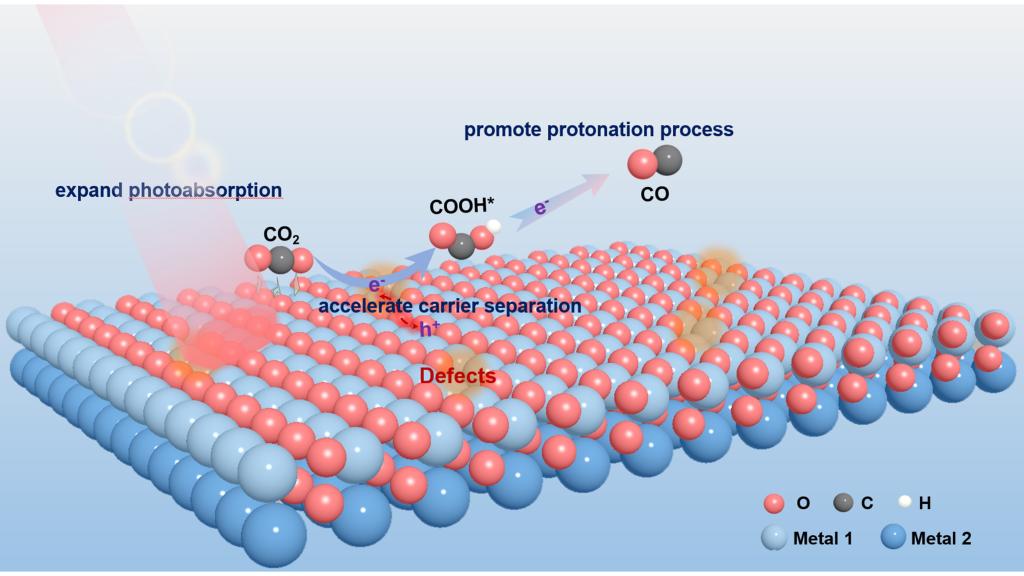《Chem. Commun》: Optimized full CO2 photoreduction process by defective spinel atomic layers
Yang Wu,+ Dongpo He,+ Lei Li,+ Zhiqiang Wang, Wensheng Yan, Junfa Zhu, Yang Pan, Qingxia Chen,* Xingchen Jiao,* Yi Xie
In recent times, the rising levels of carbon dioxide (CO2) have led to the greenhouse effect, disrupting the delicate ecological balance. Unfortunately, the escalating use of fossil fuels like coal and petroleum has resulted in a severe energy crisis. To address both the environmental pollution and energy shortage, there is growing interest in utilizing solar energy to convert CO2 into useful fuels and materials, with the aim of supporting a sustainable global carbon cycle. While significant advancements have been made in this field over the past few decades, the productivity of such processes still falls short of practical application requirements.
Defect engineering has emerged as a promising strategy to enhance the efficiency of CO2 photoreduction. By introducing defects into photocatalysts, various mechanisms can be exploited, including expanding photoabsorption, accelerating carrier separation, and promoting surface protonation reactions. However, it should be noted that some studies suggest that the introduction of defects can actually worsen the photocatalytic performance. This is because defects can also act as centers for electron-hole recombination, which hampers the overall efficiency. The contrasting effects of defects on photocatalytic performance can be attributed to the complex microstructures present in conventional catalysts, such as grain boundaries and capping agents. These microstructures can mask the true active sites involved in CO2 photoreduction. In contrast, ultrathin two-dimensional (2D) materials offer several advantages that allow for a clearer understanding of the structure-property relationship at the atomic level. These advantages include shortened carrier diffusion length, enhanced electron transport, and nearly uniform active sites. Therefore, it is important to utilize defective 2D photocatalysts as ideal models to investigate how defects influence the three fundamental processes involved in CO2 photoreduction. By studying these defective 2D materials, we can gain valuable insights into the role of defects and develop strategies to optimize their performance for efficient CO2 conversion.
In summary, our study utilized a perfect/defective spinel atomic layer model to investigate the impact of defect sites on CO2 photoreduction properties. Specifically, we focused on defective ZnGa2O4 atomic layers, which were confirmed to possess oxygen vacancies through EPR spectra, XPS spectra, and XANES spectra analysis. Further characterization techniques including UV-vis, PL, and N2 adsorption-desorption isotherms were employed to validate the beneficial effects of oxygen vacancies. It was observed that the introduction of oxygen vacancies led to increased light absorption, enhanced electron-hole pair separation efficiency, and improved CO2 adsorption capacity. Additionally, DFT calculations demonstrated that the presence of oxygen vacancies decreased the formation energy of COOH*, thus facilitating the CO2 protonation process. Remarkably, the defective ZnGa2O4 atomic layers exhibited a CO evolution rate of 17.6 mmol g-1 h-1, which was approximately 88 times higher than that of the ZnGa2O4 atomic layers under visible light illumination. This outcome clearly illustrates that the introduction of oxygen vacancies can optimize the entire CO2 photoreduction process and holds great promise for achieving high-efficiency CO2 conversion. Overall, our findings provide valuable insights for enhancing the performance of CO2 photoreduction through the manipulation of defects.
The first authors of this paper are Dr. Yang Wu and Dr. Lei Li of University of Science and Technology of China, and Dr. Dongpo He of Jiangnan University. The corresponding authors are Professor Xingchen Jiao and Associate professor Qingxia Chen of Jiangnan University.
Paper link:https://pubs.rsc.org/en/content/articlelanding/2023/cc/d3cc03520d

Figure 1. Scheme for the process of CO2 photoreduction to CO over the defective spinel atomic layers, in which the presence of defects helps to expand the photoabsorption, accelerate the carrier separation, and enhance the CO2 adsorption and protonation process.
